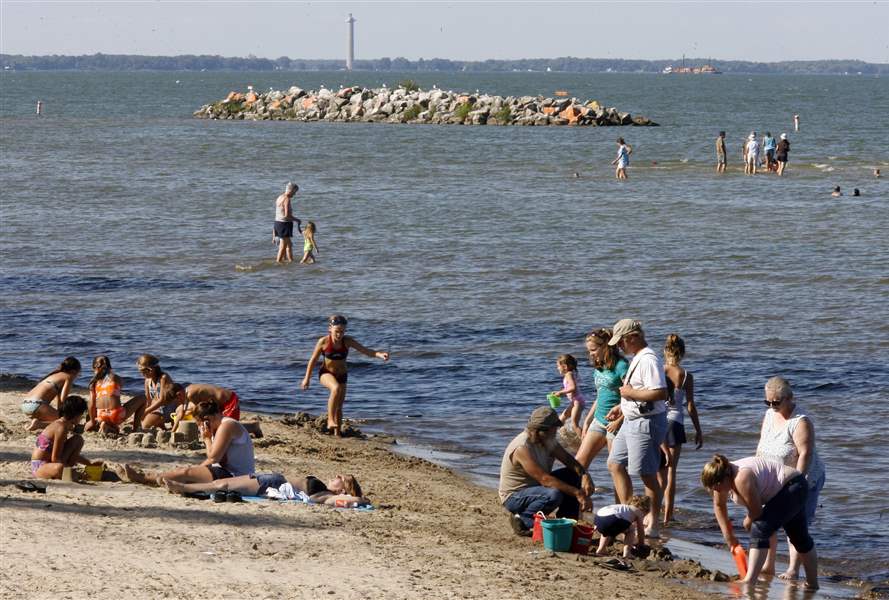
Ottawa County park posts warnings about algae
8/12/2010
In this 2006 photo, the beach at East Harbor State Park in Ottawa County has many swimmers and sunbathers. Today they are urged to avoid the water because of potentially harmful algae. Park posts warnings about algae
Jeremy Wadsworth
East Harbor State Park in Ottawa County Wednesday had what is believed to be the first algae warning for swimmers posted along Ohio's Lake Erie shoreline since at least the 1970s.
Similar advisories could be posted at other western Lake Erie beaches in the coming weeks, including Maumee Bay State Park and Port Clinton's Lakeview city beach, officials said.
They would be in addition to the occasional postings the Ohio Department of Health makes for excessive beach bacteria.
“We are now looking at other sites,” Heidi Hetzel-Evans, Ohio DNR spokesman, said. “Our managers are prepared to post [advisories] if that's what we need to do.”
Port Clinton Mayor Debbie Hymore-Tester said last night the algae mass is visible from that city's shoreline but that officials have not been asked to post warning signs yet.
“You can definitely see it out there,” she said, though adding she is not aware of any algae-related sicknesses in Port Clinton.
The potentially unprecedented health advisory for a Lake Erie shoreline beach is perhaps a cruel irony for East Harbor, the granddaddy of Ohio's park system and usually one of the state's cleanest in terms of bacteria. The park near Marblehead, which opened in 1947, was once the state's most popular.
East Harbor was singled out only because two Ohio Environmental Protection Agency staffers, Linda Merchant-Masonbrink and Amy Jo Klei, were taken aback by Lake Erie's unsightly color as they returned from a seminar at Ohio
State University's Stone Laboratory near Put-in-Bay, according to Dina Pierce, Ohio EPA spokesman.
Ms. Merchant-Masonbrink is coordinator of the state agency's harmful algae bloom program. Ms. Klei is a member of its drinking and groundwater staff. The two headed for East Harbor, the closest state-owned facility, to grab water samples, Ms. Pierce said.

Laboratory results of those samples may not be completed until as late as Monday. Rather than wait and risk more swimmers and sunbathers to exposure, the Ohio DNR put up the advisory sign, Ms. Pierce said.
Scientists have said western Lake Erie's summertime algae typically begins near Toledo and expands easterly as the summer sets in. The Toledo area is the shallowest and warmest part of the Great Lakes, with the greatest amount of algae-growing nutrients.
Officials said this summer's outbreak is the latest sign of how Ohio's struggles have worsened with a free-floating form of algae known as microcystis, which carries the same toxin linked to 75 deaths at a kidney dialysis center in Brazil in 1996. An international investigation headed by the U.S. Centers for Disease Control and Prevention showed that facility's water-treatment system had failed.
Though it would take a large amount to be fatal, people are advised to avoid body contact and to keep their pets from lapping up algae-infested water. Exposure to low levels of microcystis and other forms of blue-green algae can cause diarrhea, cramping, and nausea.
Some predict this year's bloom will be a historic one by the time the algae blooms peak in early September.
“It's a developing issue statewide, really,” Ms. Pierce said. “We fully expect this to be one of the worst years for the algae bloom out there.”
Algae warnings were issued previously at six other Ohio parks this summer, all inland bodies of water.
Ms. Pierce said the driving force has been myriad complaints about the foul stench and unhealthy conditions of Grand Lake St. Mary's in western Ohio, where dozens of dead fish have been found and officials have been investigating reports of illnesses that may be a result of algae exposure.
Now, for the first time since at least the 1970s, an advisory has been posted urging swimmers and sunbathers to avoid algae along one of Ohio's Lake Erie beaches.

The 1970s were a turning point for the lakes, the advent of modern pollution laws and sewage controls.
The lakes were blanketed by algae back then, largely because of untreated sewage.
But it is not immediately known how many, if any, swimming advisories were posted.
Most of the summertime algae disappeared until 1995, the same year that phosphorus — a common farm fertilizer that promotes algae — began rising in the Maumee River, the Sandusky River, and other area tributaries, officials have said.
Now, the bloom is an annual event again, with varying degrees of concentration. It is coming earlier and staying longer.
Sewage is not as much of a problem, though records show this summer has been a large one for municipal overflows. Ms. Pierce said the largest inputs now are from livestock manure and commercial fertilizers that get pushed into streams by heavy rain.
The Ohio Department of Health is collaborating with the Ohio DNR and the Ohio EPA on the statewide algae investigation. More details can be found on the state health and state EPA Web sites, as well as those maintained by the U.S. EPA and the U.S. Centers for Disease Control and Prevention.
Contact Tom Henry at:
thenry@theblade.com
or 419-724-6079.